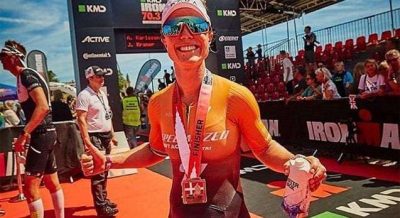
Ruth Purbrook: introducing wonderwoman
Read moreMassage
Compression
Accessories
SHOP GOALS
Video Setup Guides
Blog
About us
Warranties
I make sure I do something every day. I do four heavy sessions during the week and then I have three mobility and recovery sessions. My recovery sessions are as much of a priority as my training sessions. I think the balance is key.
Ultimately, the faster I can recover from the heavy training sessions, the better equipped I can be for the next training session. If you’re trying to get stronger, you train and get a big stimulus and then you recover and then you adapt. So, the faster you can recover the quicker you can adapt and that means you can train the muscle again to get stronger. Improving your recovery between sessions is simply the best way to get stronger in a shorter space of time.
It’s hugely important. The Quins guys have got multiple sessions in a day and then have to do that for several days in a row. After a game they have lots of lactic acid build up and impact on their muscles, if they didn’t focus on recovery they wouldn’t be able to start training properly for days after their games, it’s as simple as that.
They have a flexibility programme which we’re working on constantly with them that comprises of passive and active stretching. They do a lot of soft tissue work to loosen themselves off before training, myofascial release with peanuts and rollers. Then they have soft tissue massage every day, either with the MyoBlaster or with a masseuse. They will also be doing muscle fire-ups on key muscle groups with glute bands or with the MyoMaster pulse. Recovery is part of their daily routine, it’s the only way they can come back day after day and make the most of the training sessions.
Some people want to be the fastest in the world, I want to be the strongest.
Ooooo I’ve had a couple. Last year during Europe’s World Strongest Man I ruptured my bicep tendon lifting a 180 kilo axel which is like a set of train wheels. I pulled on the bar and my bicep pinged off and the tendon came off the bone. It was pretty devastating as we were six weeks out from World’s Strongest Man. After surgery it took me about 12 weeks to rehab it and get back to full strength.
The EMS was key to me coming back in that time, it got the muscle firing before I could train and sped up my recovery without a doubt. It helped to get the bicep mass back before I could load it properly and made sure I was targeting the muscle I needed to when I got back to training. I also did a lot of soft tissue work to make sure that the tendon and muscle was pliable and get that range of motion back.
The MyoBlaster (our deep tissue massage gun available for purchase from December 2018), I used it out in Manilla at the World’s Strongest Man finals earlier this year and it is fantastic, a great product. It’s a really quick way of loosing of any sore muscle points and trigger point and it gives you a really fast instant relief. It’s great to have in your quick bag before you go out and train.
What advice would you give to athletes who aren’t training full-time and are trying to understand how to make recovery part of their schedule?
It’s vital for anybody with a fitness goal. I’ve got a job and train on the side for strongman, so Iike many others, I’ve got a limited number of hours to train each week. If I can recover between sessions and be ready for the next one I don’t have to waste my time being sore or weak. I don’t have the luxury of having someone to give me a soft tissue massage every single day and like most people I’ve got to do it for myself so getting a solid recovery programme built into my training is key for anyone who is working towards a fitness goal.
Write down something everyday that is going to improve you. If you write it down you’re much more accountable for it. They key is to be consistent and do something that makes a difference every single day.
To win World’s Strongest Man, that’s everything I’m working for. It’s the pinnacle of the sport. Some people want to be the fastest in the world, I want to be the strongest.
My short-term goals is to win Europe’s Strongest Man in January 2019. It’s looking pretty good at the moment, I’m feeling good.
 2x MyoChill Filter
2x MyoChill Filter
 2x MyoChill+ Filter
2x MyoChill+ Filter
 Ice Bath Steps
Ice Bath Steps
 Floating Thermometer And Outdoor Foot Mat
Floating Thermometer And Outdoor Foot Mat